By Ken Perrotte
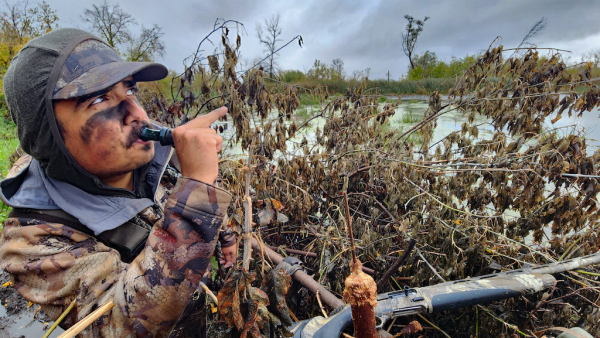
Hunting guide and marsh research technician Troy Blackwell calls to distant ducks - Ken Perrotte photo
Rain pounding on the roof of the historic Kirchhoffer Lodge and the audible – read “howling” - northwesterly wind had me awake well before my 5 a.m. alarm sounded, wondering what this weather might mean to any morning flight of ducks.
Typically, I gauge such assessments on my limited experiences in the Chesapeake Bay area, where miserable weather just as often keeps birds hunkered in protected pockets of water as it induces them to wake up and fly to feeding areas.
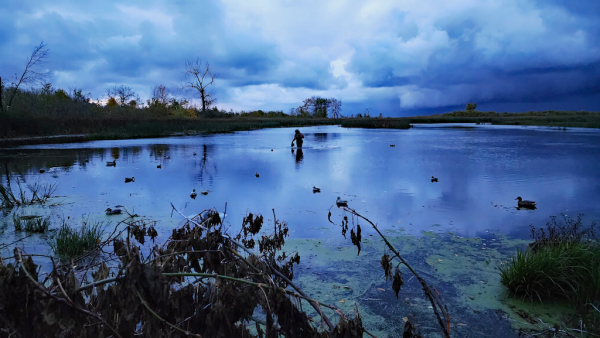
Loading into a tracked Argo, the most comfortable of these tortuous beasts I’ve ever experienced, we all snugged parka hoods tight and rumbled along a two-pronged finger of land jutting out into a small lake in Manitoba’s storied Delta Marsh. There, “geezer seats” awaited, the tongue-in-cheek name for the marsh seats that stick deep into the mud and offer a little support as you stand in the muck and await incoming ducks. Being a geezer, or at least on the cusp, the seat was most appreciated.
“My goal is for each of you to get a canvasback,” our trip leader Paul Wait, explained, the canvasback being the duck that helped make Delta Marsh so famous. However, a widely mixed bag was likely since the marsh is a prime staging area for most birds getting ready to hit the road south. Wait is the communications director for Delta Waterfowl. We were hunting as the organization’s guests and staging from their property on the north side of the marsh.
Amazing Waterfowl Diversity
I love it when the weatherman is wrong. While rain and wind were forecasted through the morning, daybreak saw the rain subside. Even the wind laid down a notch. We nestled into the cattails and scanned the sky. We didn’t wait long.
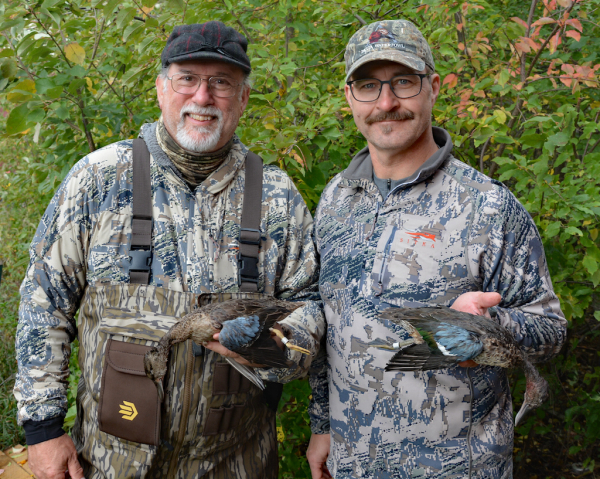
Ken Perrotte and Lowell Strauss with their banded blue-winged teal - Troy Blackwell photo
Incoming. Boom. Boom. Boom. Two blue-winged teal down, then a couple more. Two bigger ducks swooped in and then tried to climb out, realizing something was amiss. Canvasbacks! I folded the drake while Pennsylvanian David Rearick capped its partner. A few minutes later, a more fully plumed drake canvasback offered me an almost overhead shot. In a split second it took to assess this bird on the wing, my Benelli SBE3 came instinctively to my shoulder.
There isn’t much to add to the discussion about Benelli’s new Super Black Eagle 3 shotgun. It has been roundly praised and continues to win fans, especially among those who try it in weather scenarios like Manitoba. I used a black, synthetic 12-gauge model. It had the BE.S.T (Benelli Surface Treatment), meaning after a rainy day in the marsh, you cleaned off any mud and let the gun air dry until the next time out. Across three days of shooting, the proven Inertia-Driven action flawlessly cycled rounds and the Comfort Tech stock and recoil mitigation design cushioned shoulders against load-after-load of three-inch 12-gauge shells.
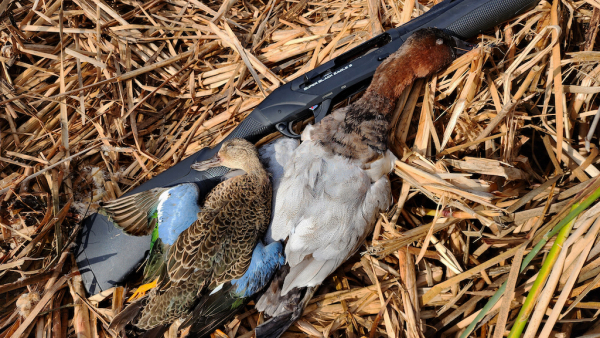
We were eager to try the new Hevi-Metal Xtreme loads, which layers 30-percent original HEVI-Shot, 12-density tungsten (number 6s) over 70-percent steel (number 3s) pellets. That leading layer of high-density tungsten smacks ducks hard, hitting reportedly 53 percent harder than the following steel layer. The shot is loaded into Federal’s FLITECONTROL FLEX wad.
Scott Turner, product line manager for Federal Premium Ammunition and Hevi-Shot, said the new Hevi-Metal Xtreme increases the density of the tungsten pellets compared to the brand’s original blended Hevi-Metal load. He explained that the size 6 tungsten, launched at 1,450 feet per second, has the same ballistic coefficient as the size 3 steel, giving you a solid pattern. With that load, that velocity offered perfect balance when it came to pattern consistency, Turner said.
“At ethical ranges [inside 40 yards], you’re not going to see different points of impact between the different densities,” Turner said. “We put the smaller tungsten up front because, after launch, it’s not pushing through that lighter density steel, so you’re not opening up the pattern.”
Turner shared that the loads we were shooting placed 84-87 percent of the total pellets inside a 30-inch patterning target at 40 yards. Incorporating Federal’s FLITECOTROL Flex wad also improves pattern consistency, Turner said. “Consistency is efficiency,” he said.
We shot a four-man limit that first morning, with most birds dead when they hit the water. Even more impressive was the diversity. We had 11 distinct species in the bag, including cans, gadwall, teal, ringnecks, shoveler, scaup, ruddies and more. And we observed three other species, including goldeneye, on the wing.

The predawn hours before day two offered similar heavy wind and rain. Fortunately, the forecast called for things to clear by 8 a.m. I hate it when the weatherman is wrong. That is precisely when the rain kicked in, lasting until noon. We were in a blind, and thankfully, the wind was blowing and gusting at our backs, roaring through trees along massive Lake Manitoba’s shoreline, just a couple hundred yards distant.
Still, we picked off birds, including many single gadwalls looking for a place to sit down. A dearth of daybreak teal had us wondering if the birds had finally decided to migrate. Many likely did, but not all. The highlight came when Saskatchewan writer Lowell Strauss and I each shot banded blue-winged teal and later learned the ducks were banded that summer close to where we hunted.
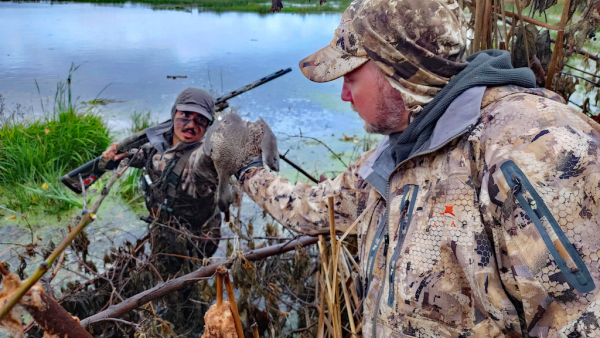
Troy Blackwell hands David Rearick a gadwall - Ken Perrotte photo
Research Rules
Research studies and annual waterfowl banding projects are among the legacy of the Delta Marsh. In 1979, a Marsh Ecology Research Project was launched involving the construction of 10 different “cells,” each capable of supporting independent research projects related to waterfowl and habitat. Some were shallow water, others deep water, enabling the study of various plant species, soils and more.
According to Wait, this project was a partnership between Ducks Unlimited and Delta Waterfowl, with DU building the cells and Delta then running the student research projects on them. At any given time, 50-75 people worked the sites. “The amount of wetland science that came out of this area is remarkable,” Wait said. “Four books and more than 100 scientific studies, doctoral dissertations, and master’s degree theses resulted from the work done over the ensuing years. The work is still relevant today.”
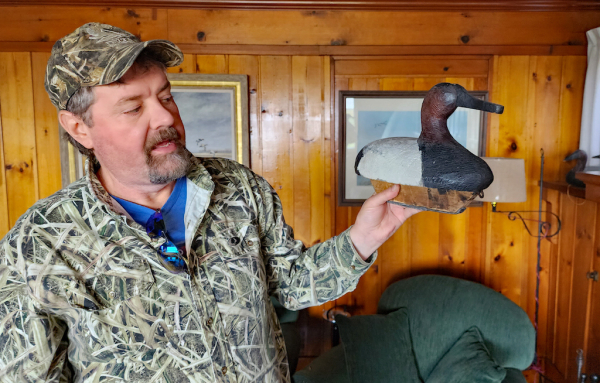
We met Delta Waterfowl’s CEO, Dr. Scott Petrie, a man who loves his dog Boone and enjoys reciprocal affection.
“He’s not much on finding birds if he doesn’t see them go down – has never had any formal training – but he loves to fetch and does a great job on ducks he marks,” Petrie said.
Petrie shared that he was a researcher at the marsh in the 1980s. The work left an indelible mark, along with a passion for the marsh and the effort throughout the Delta organization.
He and other Delta leaders see one issue as essential to the future of conservation and waterfowl hunting. There was a time when most leaders of state and federal fish and game agencies were hunters or, at least, had exposure to hunting traditions. This includes the biologists and policymakers who make recommendations and decisions about species management and habitat. Today, though, most wildlife management students, the future leaders of many conservation and governmental programs, have minimal or no such exposure. Delta’s survey research showed that about 70 percent of wildlife management students today have no hunting background.
Delta calls it a “looming crisis,” where a generation or more of people now working in wildlife policy positions lack an understanding of hunting’s many virtues and might not share or appreciate the passion hunters bring to conservation.
To address this, Delta Waterfowl began a University Hunting Program in 2017. They actively recruit professors and students, offering instruction that complements regular wildlife courses. A central part of the program is getting these young professionals out shooting and experiencing the wonder of a hunt, whether a field hunt for geese or a magical moment in a marsh. They experience the planning, logistics, and camaraderie and see the incredible bond between hunters and their dogs. Ideally, they also feel that adrenaline-fueled moment when they realize they are transitioning from a watchful observer to an active participant in a tradition as old as humanity.
“We know not all of them will become hunters, but we do know we are planting seeds,” Petrie said.
The program operated at 72 universities (with 415 students) last year: Yale, Cornell, Penn State, Florida State and Ohio State. More than 100 are expected to be participating soon.
“We want to keep rolling this out to as many universities and colleges that offer wildlife management degrees as possible,” Petrie said.
Another program called “First Hunt” targets waterfowl hunter recruitment. Wait calls it the “largest” worldwide, having had more than 100,000 participants since its inception in 2003. That program aligns with one of Delta waterfowl’s “Four Pillars” approach to waterfowl conservation, the HunteR3 (hunter recruitment, retention, reactivation) pillar. Other pillars include Duck Production (Hen Houses, Predator Management), Habitat Conservation (policy work, Working Wetlands program), and Research and Education (master’s and Ph.D. research).
Canada Waterfowl Hunting Nuances
Mid-September through October is the peak season for waterfowl hunting in Canada. Birds are leaving breeding grounds and readying to migrate south. Social media feeds of waterfowlers are usually full of images of bountiful hunts as friends and associates ply the marshes and fields across southern Canada.
Each province has its own rules and licensing systems. A little research usually yields hunting regulations and license applications available online. Manitoba, for example, requires nonresidents to apply for a General Foreign Resident Migratory Game Bird Permit ($218 Canadian), plus buy a Migratory Game Bird Hunting Permit – their version of a duck stamp – at $17.
In a legislative move causing consternation among traveling waterfowlers, Manitoba is moving to a draw system, something expected to limit opportunities for nonresidents. There will be no more “over-the-counter” sales, and licenses will be good for one seven-day period annually. Those who hunted this year had to apply, but we were assured of a license if we applied within a certain date range.
Manitoba produced a guide about the upcoming changes, stating requests from resident hunters and outfitters in Manitoba who reported intensified hunting activities by foreign resident hunters in recent years prompted the changes. These hunters are “increasingly staying longer and controlling access to waterfowl hunting lands…Increased competition for access to hunting areas has adversely affected the quality of waterfowl hunting experience in Manitoba,” according to the guide.
In the future, nonresidents can enter a draw with a mostly low probability outcome or buy a tag from a licensed outfitter. The changes have garnered criticism from waterfowl hunters and conservation organizations.
Other provinces, so far, haven’t followed suit.
You must complete a Non-Resident Firearms Declaration to bring a nonrestricted gun (most hunting shotguns and rifles) into Canada. Don’t sign it until you are in the presence of a Canadian officer. This has a $25 fee. Get a U.S. Customs and Border Patrol Form 4457 before you travel. This documents that the gun you’re bringing out of Canada is, in fact, yours. I traveled back from Africa once without this form. It was a painful hassle getting my gun cleared back in.
Canadian airlines have different rules related to flying with firearms and ammunition. Things that are acceptable with U.S. carriers often “don’t fly” with the Canadians. Always verify guns and ammo rules before packing.
Traveling to hunt has its rewards and challenges. Still, I can assure you that waterfowl hunting in Canada can spoil you -- especially if you’re an often-frustrated Atlantic Flyway hunter who rarely scratches out a limit of anything except good times afield with my dog. One thing is certain: it is helpful to have organizations like Delta Waterfowl and Ducks Unlimited that operate across borders and advocate for duck hunters and our waterfowl resources.